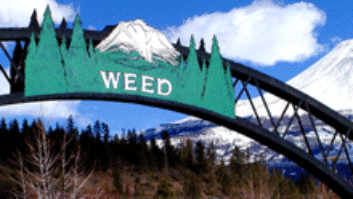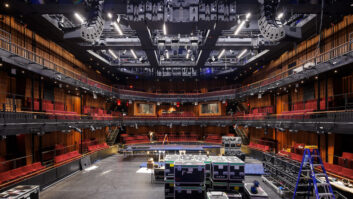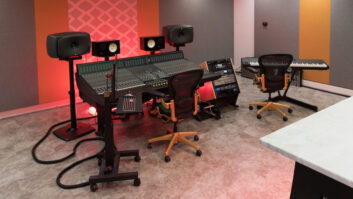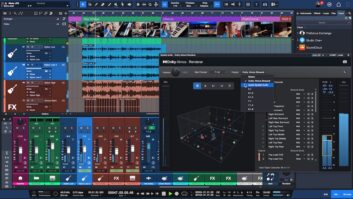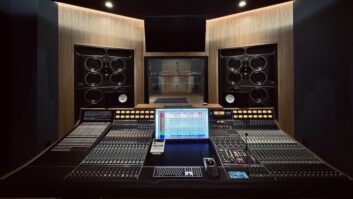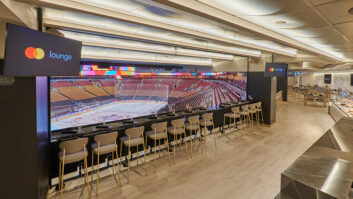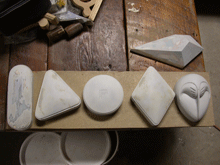
The National Recorder Label (National Recorder LLC): A record label specifically created to help develop new artists who have finished their records at RadioStar. Distributed nationally by Universal through Fontana, with the first album slated for release in mid-May by the band Skies of America.
The Weed Palace Theater: The Weed Palace will be re-opened as a live venue within the next year. The theater will feature a restaurant, concessions, gift shop and balcony bar. The new concession counter has already been completed and the balcony is currently under construction. The theater was originally built as a Vaudevillian show-house in 1912, and RadioStar will update the large stage with computerized lighting and a modern sound system, as well as restore the outside tower marquis with the name “W-E-E-D” in neon down the front of the building.
The Black Swag Clothing Company: With several clothing lines already in production, including vintage audio-themed prints and Weed souvenir shirts. Every band that works at RadioStar leaves with one of these custom-printed shirts.
Custom Guitar Pedals: Prototype designs for a line of custom pedals have already been made, with beta testing of the electronics ongoing during studio sessions in RadioStar. The pedal line is expected to be ready for commercial release in 2007. Also planned is a series of custom guitar designs and rackmounted audio gear.
National Cinematic: A video production company, filming and editing EPKs (electronic press kits) and full soundstage music videos. Equipment includes Canon XL1 cameras, Avid and Final Cut Pro editing systems, as well as a vast array of professional and effect lighting systems. Plans are underway for National Cinematic’s first full-length movie production, with all soundtrack music recorded in-house at RadioStar.
The National Academy of Entertainment Technology: NAE-Tech is a trade school featuring studies in audio recording, music business, live sound re-enforcement and video production with specialized instruction in rock music production, running your own independent label and high-tech music marketing. Slated to accept its first students for a certificate program in the fall of 2006.

National Roadshow: A touring company designed to provide impressive custom-designed touring rigs for developing artists on tight budgets. Working directly with the National Recorder label, the Roadshow will provide its 54-foot traveling monster rig for the summer 2006 tours planned to support the label’s new releases.
More Rare, Vintage and Weird Gear From RadioStar
Fairchild 670 Stereo Tube Compressor
The real thing, a miracle on a mix. Gives everything a warm, finished feel. Tends to dull the mix slightly, which can sometimes actually be a good thing. Oh, so analog!

The “Army Man” Western Electric RA121 Compressor
Found this in a garage in Oakland, Calif. Guts hanging out, yeah, it’s a hazard to have around, but put a guitar signal through this and it bites like a rabid dog! I’m sure there’s something very broken about this compressor, but we are afraid to fix whatever the problem is because there’s nothing that sounds like it. Someday we may dissect the damn thing to find out why it sounds the way it does so we can design a box to emulate it. Nicknamed the “Army Man” because of the little plastic man that was so brazenly glued inside it during the System of a Down sessions.
Universal Audio 175b Tube Compressor
If this is followed by a UREI 1176, you have the magic combination for vocal recording. The 175b has to be my favorite tube compressor.
Gates “Level Devil” Compressor
This is a big tubey monster, and the little graphic of the devil on the meter is probably what makes it so cool to have around. Oh, yeah, it sounds good too!
Gates “Sta-Level” Tube Compressor
The poor-man’s LA-2A. A secret weapon for getting earthy, warm tones out of vocals. This is what made Johnny Cash’s vocals so intimate and woody on the Unchained album.
ITA LA-1A Compressor
Yes, before the LA2-A, the LA-3A and the LA-4, there was the LA-1A. A big-ole, sweet-sounding, tube-filled beast. Super-rare.
Neve 1073 EQ
We have a whole bunch of these babies, and they make you look like a freakin’ genius when you plug a mic into one because it will always sounds good.
Dildo Mic (Make and Model Unknown)
Its intriguing shape first caught my attention, and I bought it along with a box full of other old crystals and early dynamics for cheap. I originally purchased the mic for Maynard to use on the Tool Aenima record, but when royalty negotiations broke down before we started recording, I was the one who wound up getting the shaft!

Telefunken U47 Mic
When you need that clear, warm intimate vocal sound, this is usually the right mic for the job. I wish we had 10 of these.
Shure SM57
It may look like a regular old SM57, but it’s not. This is the mic that David Bowie sang in, and it has his breath and spit on it, making it extra precious. It is brought out only on special occasions. I was assisting at Larrabee Sound during the time Bowie was recording the second Tin Machine record. For some reason, there wasn’t a 57 in the house, so I volunteered mine. Who knew that he would prefer to use that $100 mic for his vocals?

Teisco Table-Top Guitar Amplifier
A little Japanese guitar amp shaped like an end table for your weird plastic ’70s living room ensemble. Sounds pretty horrible, but is a great place to set your coffee mug while playing through a guitar amp.
Piggy Amp
We have zillions of similar little combo amps—by Airline, Supro, Danelectro, Silvertone, Guyatone, Magnatone, Valco, etc.#151;and they all have their own special sound. But this one is freakin’ amazing#151;a bluesy, growly little animal. And it’s battery powered, as well as AC powered, so you can take it camping!
Matchless DC-30
I was so lucky to get this amp. I had made the order, paid for it and waited and waited. During my wait, the company went under. I fully expected to never see the amp#151;and then there it was, six months later, at my door! Not exactly the color I ordered, but a DC-30 nonetheless, and I’ve never had reason to complain. This amp has unbelievable harmonic overtones that I’ve never heard on any other guitar amplifier.
Roland Space Echo
One of our most important effects units in the studio. There is hardly anything as magical as an inspired performance on this unit with just the right amount of “intensity”#151;with the easily recognized signature of the landing alien craft.
Chamberlin M-1 Keyboard
Richard Chamberlin’s contraption, built in his garage in Los Angeles around 1970. Chamberlin made the first tape-based sampler keyboards ever, using actual recordings of instruments instead of the mostly fake-sounding synthesized versions of the time. On this M-1, each key on the keyboard has a tape head, and when the key is pressed, a strip of 5-track tape is pulled across the head for that key. When the key is released, the tape retracts back into a tape measure-type spring-loaded cylinder. Chamberlin went on to create and license another tape loop-based keyboard design for Britain’s Mellotron company, whose models unfortunately eclipsed his own namesake designs in popularity.
Chamberlin Rhythmate Drum Machine
The accompanying rhythm section for the Chamberlin M-1. A stand-alone speaker box that plays continuous 3-track tape loops, including bossa nova, fox trot and early rock ‘n’ roll beats. So rare and precious, we only pull it out for special occasions.
Mellotron 400 Keyboard
Playing a real Mellotron on a record has its challenges. You may have to tune each note individually and play them one-by-one. The initial touch of the keys can’t be too hard if you don’t want it to sound abrupt. You have to overlap the playing of one key to another to give it a fluid feel. And you must learn how each key is reacting that day and adjust your playing and volume to the Mellotron’s mood at that moment. Sounds complicated? It is, but the results are so worth it, as your strings will have the most other-worldly sound to them.

ARP 2600 Synthesizer
Billed as the actual synth that made the helicopter sound in Apocalypse Now. This is one of the funnest instruments to pull out on a session#151;sure to waste hours of precious studio time.
Optigan Keyboards
Originally made by toymaker Mattel in the ’70s, this keyboard uses clear plastic optical discs to play a variety of keyboard sounds and accompanying rhythms. Pretty cool just operating it normally, but really weird when you flip the discs upside-down or stack two discs on top of each other. Total acid trip! They can still be found in thrift stores; in fact, one of the two I have was found in my favorite local shop for $25.
Vaudevillian Piano
This is an original fold-up piano used by clowns and other traveling entertainers around the turn of the century. Incredibly enough, it has a real iron harp, ivory keys and uses real piano strings. And it’s really, really heavy.
1960s Coral Sitar Guitar
A unique guitar I discovered while working on Tool’s Undertow record. You’ll hear it featured on the song “4 Degrees.” It has a completely unique sound, a Middle Eastern twang and shimmer that ads a special color to recordings.
1960s Ampeg Scroll-Top Bass Guitar
Bought this from Exene’s “God Save Us” thrift store in L.A. Used to belong to John Doe from the band “X.” It has the original flat-wound strings on it, never changed from the day I bought it. The strings are completely dead, and the instrument sounds dry and tubby like a stand-up bass. Sometimes just the perfect sound for a creative interlude.
1963 Fender Gold Stratocaster
One of the most popular instruments in the house, I found this Strat in a music shop in Yuba City, California, for $175. Yeah, it didn’t look like this though. Andy Braur in Los Angeles stripped it down, replaced the unoriginal bits with new-old-stock parts and gave it a new paint job. Okay, it’s not a pure, unadulterated 1963 Strat, but it is the most amazing and beautiful-sounding studio tool!
1961 Fender Esquire
Now here’s the real thing, with a crystal-clear Tele sound. The Fender Esquire was designed with a Telecaster body, but only has one pick-up instead of two. Supposedly, the Esquire guitars sparkle more and have a greater sustain than Teles because one less pickup means one less magnet pulling on the strings. Mike Campbell and Tom Petty enjoyed playing this guitar on the song “She’s the One” and on the Johnny Cash sessions.
1968 Gibson SG
This awesome instrument gets brought out for nearly every session for some reason. It just has something special about it, like it’s alive or something. Found it in an obscure shop in Colorado. The shop owner took me behind the counter into a back room where he had 30 or so vintage SGs all lined up on a wall. I can’t tell you where that shop is because I imagine the other 29 SGs are still there, and I might just need another one.
1990 Fender Gemini Acoustic Guitar
Not our best acoustic guitar for sure, but this is the one that Prince singled out to use on “Diamonds and Pearls.” You can hear its dry tone on several songs. After using it, he asked if he could buy it from me, to which I promptly replied, “No.”
Ludwig ’70s “Black Beauty” Snare
For some reason, this snare always works in the studio. Not sure exactly why, but this old brass-shelled snare has more power and punch, and makes the most inconsistent player sound steady and solid. If you are looking for one, make sure it has the trapezoidal logo plate with the olive color.
